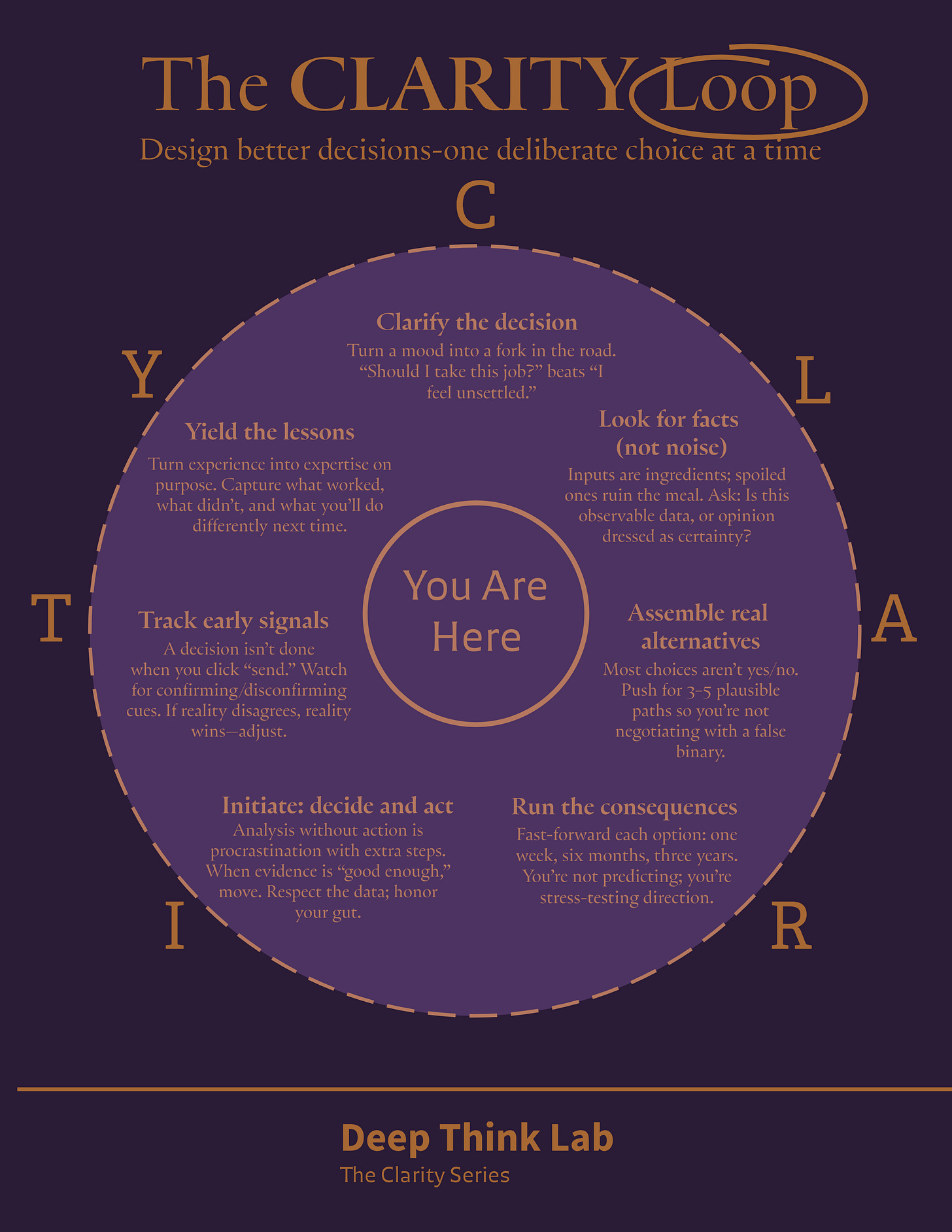On a Tuesday no one will remember, a manager named Lena stood at the office fridge, eyeing the leftover pad thai beside the salad she’d packed. Six seconds later, she shut the door with noodles in hand.
That afternoon landed differently. A sleepy 2 p.m. check-in nudged a tricky email to “later,” which delayed a vendor reply, which slipped a shipment, which pushed a deadline, which put Lena on the phone Friday night smoothing a client relationship instead of sitting on metal bleachers at her daughter’s soccer practice.
Six seconds became six days.
We like to believe our lives pivot on the big moves—new jobs, new cities, new relationships. But more often, it’s the quiet, accumulate-in-the-corners choices that set our drift. The hard part? We’re standing inside the system we’re judging. We mistake movement for progress, preference for principle, urgency for importance. Intelligence isn’t the issue. Vantage point is.
Here’s the liberating part: effects have causes, and you’re creating those causes right now. Design the small choices—and the big outcomes start pre-shaping themselves.
From Choice to Clarity
After watching that small choice ripple through her week, it’s easy to see the pattern: our decisions don’t fail because we’re careless—they fail because we’re unclear. We act from mood, not structure. We react, then rationalize. What we need isn’t more intelligence; it’s a way to slow the blur long enough to see what’s actually happening.
That’s where the CLARITY Loop comes in. It’s a mental model designed for real life—fast, flexible, and simple enough to use when your brain is already tired. Whether you’re choosing lunch or a leadership strategy, the process stays the same.
The CLARITY Loop: a decision model you can actually use
A good model should fit on a sticky note and work under pressure. This one does. Print it. Post it. Use it.
The CLARITY Loop isn’t just a framework—it’s a practice. It’s designed for those small, real-world decisions that pile up and shape how your week (and career) unfolds. Use it when you’re stuck between two options, overthinking a move, or just need to pause and make a better next choice.
Let’s walk through it.
C — Clarify the decision
Start by naming what you’re really deciding.
Most of us confuse feelings with forks in the road.
“Should I take this job?” is a decision; “I feel unsettled about my career” is a mood.
Write your decision as a question—it forces your brain to find answers instead of staying foggy.
Tip: Say it out loud. If it sounds vague, it probably is.
L — Look for facts (not noise)
Next, get clear on what’s true.
We drown in advice, opinions, and half-truths. Separate the signal from the static.
Ask yourself: What do I actually know? What have I only heard?
Treat your inputs like ingredients—spoiled data makes bad decisions.
Reality check: if you can’t verify it, it’s noise.
A — Assemble real alternatives
Most choices aren’t yes/no—they’re which of these fits my values best?
Push yourself to create at least three to five real options.
The first idea that pops into your head is rarely the best; it’s just the easiest.
Generating alternatives builds flexibility and reduces regret.
Think of it as widening the playing field before you take your shot.
R — Run the consequences
Now, stretch each option forward in time.
What happens if you choose this path a week from now? Six months? Three years?
You’re not predicting the future—you’re stress-testing direction.
Some paths create quick wins and slow pain; others do the opposite.
Seeing those tradeoffs early helps you choose consciously, not reactively.
Time is the best lens for seeing risk.
I — Initiate: decide and act
At some point, thinking turns into stalling.
Once your evidence is “good enough,” it’s time to move.
No model can make uncertainty disappear—but clarity gives you confidence to act.
Respect your reasoning. Honor your gut. Commit.
Clarity without courage is still indecision.
T — Track early signals
A decision doesn’t end when you click send or say yes.
Every choice sends out ripples—watch what comes back.
Are early results matching what you expected? If not, adjust.
Reality is your feedback system; pay attention before small drifts become big detours.
What you track, you can improve.
Y — Yield the lesson
Finally, close the loop.
Every decision—good or bad—teaches something, but only if you pause to capture it.
Ask: What worked? What didn’t? What would I do differently next time?
Documenting your learnings turns experience into insight—and insight into wisdom.
Reflection is the compound interest of good thinking.
When you start using the CLARITY Loop, you’ll notice something subtle: decisions become less about pressure and more about rhythm. Each loop teaches you where you tend to hesitate, overthink, or rush. The goal isn’t perfection—it’s pattern recognition. Once you see your patterns, you can start shaping them.
That’s where daily decision habits come in—the small, game-changing practices that make clarity your default state instead of a lucky accident.
Four Game-Changing Practices
Limit your options early.
Having twelve choices may feel empowering, but it usually ends up paralyzing. Prune to the best three before fatigue prunes your judgment for you.
Include the people you’d normally exclude.
Invite the quiet stakeholder, the downstream user, the person who has to live with the outcome. Surprising voices prevent predictable mistakes.
Make your criteria visible.
Write down what matters and why. Hidden assumptions are the saboteurs of otherwise good decisions.
Set a deadline.
Perfectionism kills more opportunities than bad decisions do. “Perfect” stalls, but “Done” compounds.
Build the Skill Daily
Decision-making is a muscle. Train it like one:
Own your choices publicly.
Explain your reasoning—especially when things don’t work. Accountability sharpens thinking.
Reflect regularly.
Friday afternoon prompt: Which three decisions shaped my week, and what would I do differently next time?
Get comfortable with uncertainty.
Many choices don’t have a “right” answer—only a direction that fits your values. Pick, move, learn.
Conclusion: Two Small Endings with Big Consequences
Ending One: The Fridge.
Lena opens the door again. Same pad thai. Same salad. But now she’s named the decision (“What lunch best supports the work I need to do this afternoon?”), made criteria visible (energy, focus, timing), and set a ten-second timer. Maybe she still picks the pad thai—and schedules the hard email for 12:55 p.m., before lunch. One micro-adjustment. Different afternoon. Different week.
Ending Two: Your Week.
A year from now is being assembled out of this week’s choices. That’s not pressure; that’s power. Small choices are levers. Pull them with intention and systems tip.
They won’t tip on their own.
Start with one decision today. Define it clearly, consider it thoughtfully, and make it confidently. Then do it again tomorrow. This is how better futures get built—one deliberate choice at a time.
About Deep Thinker Lab
I’m Jeffrey Miller, an educator and writer exploring how we think, decide, and create meaning in a noisy world.
The Clarity Series is my ongoing project on practical metacognition—simple models to help curious minds think better and lead wiser.
If this resonated, share it with someone making a hard decision today.
Because clarity grows when it’s practiced—together.



